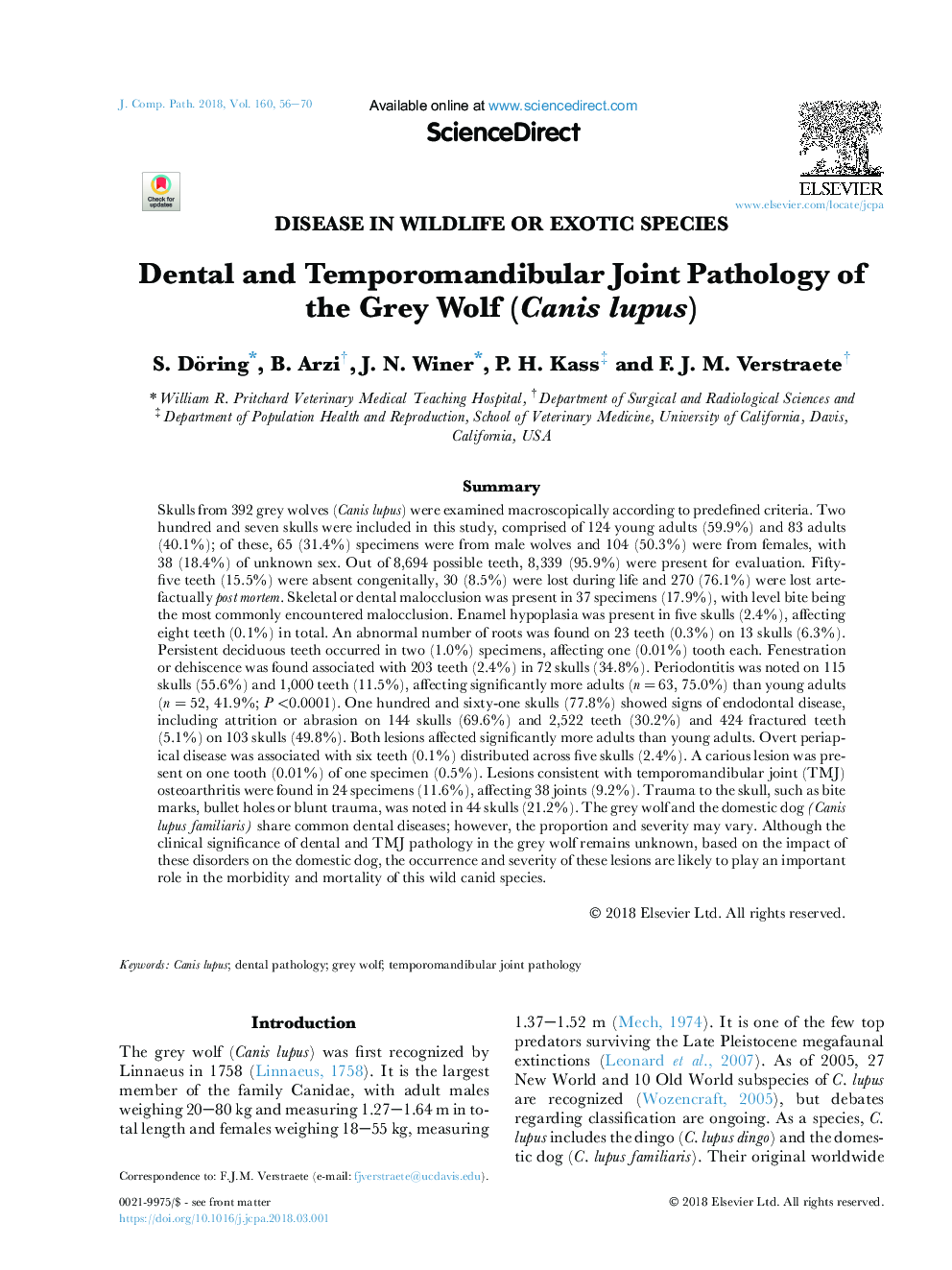| کد مقاله | کد نشریه | سال انتشار | مقاله انگلیسی | نسخه تمام متن |
|---|---|---|---|---|
| 8500426 | 1553751 | 2018 | 15 صفحه PDF | دانلود رایگان |
عنوان انگلیسی مقاله ISI
Dental and Temporomandibular Joint Pathology of the Grey Wolf (Canis lupus)
دانلود مقاله + سفارش ترجمه
دانلود مقاله ISI انگلیسی
رایگان برای ایرانیان
کلمات کلیدی
موضوعات مرتبط
علوم زیستی و بیوفناوری
علوم کشاورزی و بیولوژیک
علوم دامی و جانورشناسی
پیش نمایش صفحه اول مقاله

چکیده انگلیسی
Skulls from 392 grey wolves (Canis lupus) were examined macroscopically according to predefined criteria. Two hundred and seven skulls were included in this study, comprised of 124 young adults (59.9%) and 83 adults (40.1%); of these, 65 (31.4%) specimens were from male wolves and 104 (50.3%) were from females, with 38 (18.4%) of unknown sex. Out of 8,694 possible teeth, 8,339 (95.9%) were present for evaluation. Fifty-five teeth (15.5%) were absent congenitally, 30 (8.5%) were lost during life and 270 (76.1%) were lost artefactually post mortem. Skeletal or dental malocclusion was present in 37 specimens (17.9%), with level bite being the most commonly encountered malocclusion. Enamel hypoplasia was present in five skulls (2.4%), affecting eight teeth (0.1%) in total. An abnormal number of roots was found on 23 teeth (0.3%) on 13 skulls (6.3%). Persistent deciduous teeth occurred in two (1.0%) specimens, affecting one (0.01%) tooth each. Fenestration or dehiscence was found associated with 203 teeth (2.4%) in 72 skulls (34.8%). Periodontitis was noted on 115 skulls (55.6%) and 1,000 teeth (11.5%), affecting significantly more adults (n = 63, 75.0%) than young adults (n = 52, 41.9%; P <0.0001). One hundred and sixty-one skulls (77.8%) showed signs of endodontal disease, including attrition or abrasion on 144 skulls (69.6%) and 2,522 teeth (30.2%) and 424 fractured teeth (5.1%) on 103 skulls (49.8%). Both lesions affected significantly more adults than young adults. Overt periapical disease was associated with six teeth (0.1%) distributed across five skulls (2.4%). A carious lesion was present on one tooth (0.01%) of one specimen (0.5%). Lesions consistent with temporomandibular joint (TMJ) osteoarthritis were found in 24 specimens (11.6%), affecting 38 joints (9.2%). Trauma to the skull, such as bite marks, bullet holes or blunt trauma, was noted in 44 skulls (21.2%). The grey wolf and the domestic dog (Canis lupus familiaris) share common dental diseases; however, the proportion and severity may vary. Although the clinical significance of dental and TMJ pathology in the grey wolf remains unknown, based on the impact of these disorders on the domestic dog, the occurrence and severity of these lesions are likely to play an important role in the morbidity and mortality of this wild canid species.
ناشر
Database: Elsevier - ScienceDirect (ساینس دایرکت)
Journal: Journal of Comparative Pathology - Volume 160, April 2018, Pages 56-70
Journal: Journal of Comparative Pathology - Volume 160, April 2018, Pages 56-70
نویسندگان
S. Döring, B. Arzi, J.N. Winer, P.H. Kass, F.J.M. Verstraete,